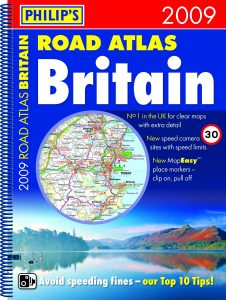Road atlases are still a driving force
WHEREVER you are going, it’s always a good idea to have a good map in the car with you.
The credit crunch has forced record numbers of Britons to holiday at home this year, and with tight budgets in mind, Philip’s is warning drivers not be led on costly detours by errant sat-nav devices.
Philip’s Road Atlases are offering 10 reasons why you should invest in a trusty atlas.
Stephen Mesquita, Philip’s Road Atlas expert says: “With petrol prices continuing to rise, you simply can’t afford for your sat-nav to take you in the wrong direction. You need the quickest and easiest route to your destination and no one should be relying purely on sat-nav for the answer.”
“Sat-nav isn’t infallible, you need an old-school backup and there is nothing more reliable than a trusty road map to ensure a hassle free road trip. A wise motorist will plan their journey before they set off, checking the route on a map first and using satnav for additional guidance only”.
10 reasons to invest in a road atlas to get you from A to B:
1. Sat-navs don’t show you further than the road you can see ahead, with an atlas you can visualise your journey and drive with more confidence that you are heading in the right direction.
2. With a road atlas, you can easily plan a journey with several pit stops and check to see if there are places or tourist attractions on or near your route that you might like to visit.
3. A road atlas costs much less than a sat-nav. Even the most rudimentary gadget will cost you ten times as much as an atlas – and probably more.
4. Updates for atlases are much cheaper and more straightforward to use. (Simply buy a new one and throw away the old one).
5. No one will break into your car to steal your trusty road atlas. Let’s face it, no matter how useful they are, the resale value just isn’t there.
6. You can rely on an atlas to show you the quickest or shortest route – a sat-nav often doesn’t. One on-line car dealer believes sat-nav can add as much as 600 miles a year to car journeys.
7. Atlases don’t lose signal or ‘hang’. If a sat-nav system crashes, it can leave its hapless user high and dry.
8. Drivers using road atlases don’t need to follow the herd. When sat-nav gives prior warning of a traffic hold-up, hundreds of vehicles can be re-directed down the same narrow lanes.
9. When you read a paper map, you don’t give up your common sense. It’s usually sat-nav drivers, not map readers, who drive into rivers or get stuck in farm tracks.
10. It’s quicker and easier to use a map when two people are travelling together. According to Computing Which? Magazine, a driver and navigator covering a set route using an atlas went a distance of 67 miles in one hour and thirty five minutes. Using sat-nav a different car took eight minutes longer and covered more than 70 miles to complete the same journey.
Whether you’re a regular sat-nav user worried by the latest headlines or a traditional map user, Philip’s has a road atlas to suit everyone.
The latest Philip’s Road Atlas Britain features fully updated maps from the Philip’s digital database, which has been voted Britain’s clearest and most detailed in an independent consumer survey, and includes speed-camera locations and the associated speed limits. It provides superbly detailed mapping of the whole of Britain. 96 pages of road maps cover Britain at 3 miles to 1 inch. The maps clearly mark service areas, roundabouts and multi-level junctions, and in rural areas distinguish between roads over and under 4 metres wide – a boon for drivers of wide vehicles.
For more information and details on the complete range of Philip’s products, visit www.philips-maps.co.uk.

